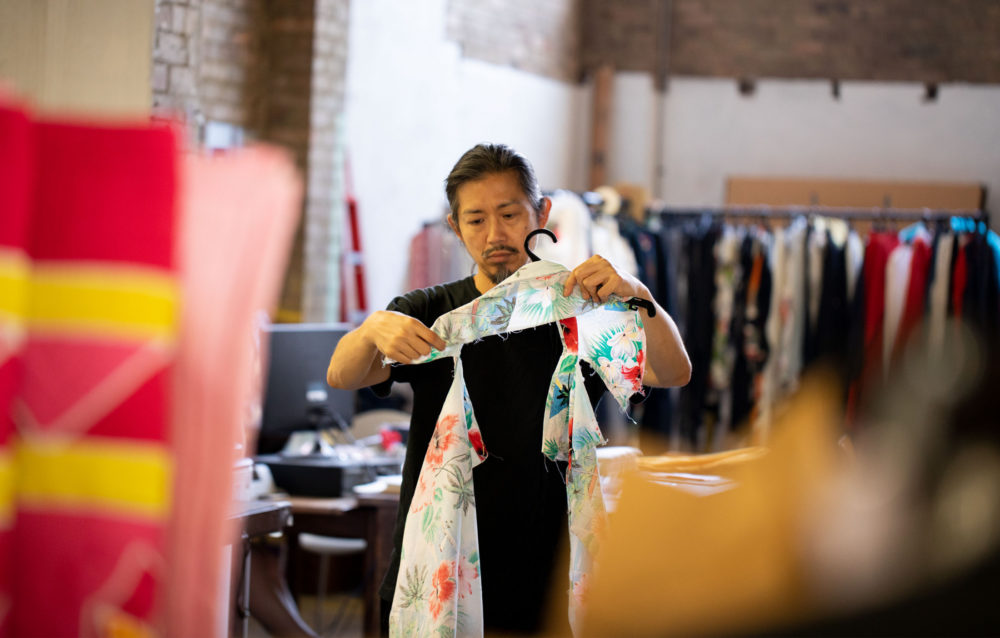Isogawa’s creative career is now the subject of a book, Akira Isogawa: Unfolding a Life in Fashion, and a retrospective exhibition opening at the Powerhouse Museum in Sydney on December 15.

“Akira’s contribution to Australian culture cannot be underestimated,” says Museum of Applied Arts and Sciences senior curator Roger Leong. “His colours, the shapes and the delicacy of the textiles and embellishments draw predominantly on aspects of Japan but also Bali, China and India. Akira translates all of these elements into a contemporary expression of Australia at the junction of these cultures.”
View FIB’s Akira documentary here:
Akira Isogawa the exhibition includes 80 pieces donated to the Powerhouse from Isogawa’s archives and is structured around four main themes. Journey, Kimono, Craftsmanship, Collaboration.
“Journey” follows the path that brought the designer to Australia, where a newfound sense of freedom allowed him to break with conservative Japanese tradition and follow his heart into fashion.
“Kimono” explores his fascination with a traditional garment that has been evolving since the Heian period (794-1192), and the many ways he has deconstructed, manipulated and reinvented it. “Growing up in Japan, kimonos were always traditional wear for me. They were not something I associated with fashion,” says Isogawa. “When I returned to Kyoto after moving to Australia, that’s when I realised the beauty of kimonos and the uniqueness of their motifs and colour combinations.”
The “Craftsmanship” section explores the way Isogawa works with craftspeople in Asia, India and Australia to create original textiles, embellishments and embroideries.
“Collaboration” examines his creative relationships with his long-time muse, the collage artist Christiane Lehmann; Sydney textiles company Signature Prints, the archives of which he mined for fashion collections inspired by Florence Broadhurst’s wallpaper prints; and choreographer Graeme Murphy and the Sydney Dance Company.
Isogawa was born on December 25, 1964 into a Kyoto family where tradition was everything, discipline was high, expectations were fierce and much remained unsaid.
Isogawa’s father, Hisao, belonged to a clan that was profoundly protective of its bloodline. Isogawas had lived in the same location for hundreds of years but male heirs were in short supply. With Akira being a gay man, the birth of Akiraʼs brother, Takeshi, in 1960 was “a big deal”, marking the first child of its generation who could carry on the family line.
Akira grew up surrounded by kimonos, uninterested in sport preferring to spend his time drawing.
Isogawa arrived in Australia in 1986, aged 21, his interest in visiting sparked by postcards he’d received of Sydney. He took up a fashion design course at East Sydney Tech two years later. Around this time, he chanced upon lucrative work as a Japanese tour guide with a sideline selling Australian opals.
The money enabled him to open his first store in 1993 on Queen Street in Woollahra,
offering a mix of his own designs and imported items. One of his first customers was a young woman named Cate Blanchett, who was studying drama at the National Institute of Dramatic Art.
“Today Akira Isogawa is a pillar of the Australian fashion industry [but] it’s easy to forget just how startling his perspective was for the very Eurocentric Australian industry of the ‘90s,” says Blanchett, who wrote the foreword to the book. “He helped to broaden Australia’s fashion focus in the most beautiful, graceful and gentle way – a way that typifies the man himself.”
“A signature of Akira’s approach is that he always puts the exploration of beauty
above business,” says Blanchett. “As one of his many admirers, I have, over the years, acquired several of his pieces. Not only do I wear them year in, year out, but I treasure them as precious works of art.”
Unlike your garden variety fashion auteur Akira seems unfazed by fame, nor remotely interested in fortune. Everything he makes is done from start to finish in his Marrickville atelier. There is a sense of the ancient in the fabrics he chooses, but a clean modernity in the shapes of the ensembles he creates. He is a living embodiment of the spirit of Kyoto, where the ancient coexists alongside the hyper modern.
Akira is an anachronism in the world of high fashion. Unlike the other attention seeking peacocks and flamboyant provocateurs taking their bows on the world stage he remains shy, softly spoken and humble. In fashion he is the ultimate outsider. He appears uninterested in trends, or the number of followers he has on social media. Just an artist surrounded by fragments of beauty trying to piece them and the meaning of life together.







